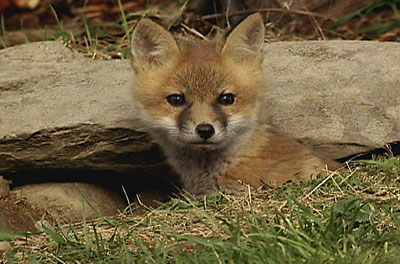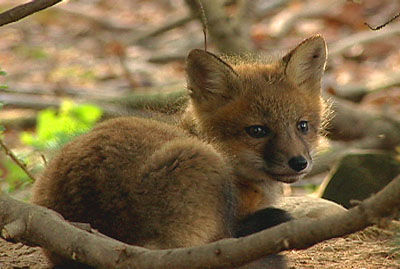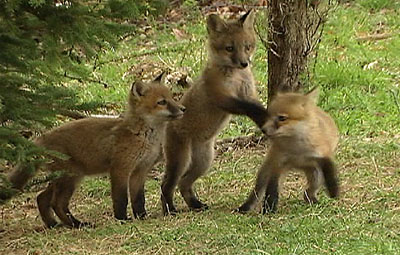Photographing Red Fox Dens
 Networking
is a word that's getting lots of play these days. I don't really know when
the word came into common usage but, with the burgeoning use of computers,
the internet and the interconnectedness of all the electronic
contraptions, information is disseminated at a dizzying speed. As I said,
I don't know when the word "networking" came into common usage
but, although the word may be new, the concept is as old as man, or, at
least as old as the time when early man actually used guttural gruntings
to convey a message. Networking
is a word that's getting lots of play these days. I don't really know when
the word came into common usage but, with the burgeoning use of computers,
the internet and the interconnectedness of all the electronic
contraptions, information is disseminated at a dizzying speed. As I said,
I don't know when the word "networking" came into common usage
but, although the word may be new, the concept is as old as man, or, at
least as old as the time when early man actually used guttural gruntings
to convey a message.
 I
bring this up because over half of all the subjects I photograph are the
result of someone telling me where to find those subjects. I am truly
thankful that I have such a large circle, a network, of friends who are
willing to help me because, I simply could not make all of these
discoveries by myself. I also have the advantage of living in a rural area
where so much of this activity is taking place all around me. I would
advise anyone interested in doing wildlife photography, to let as many
people as possible know about your interests, and don't hesitate to ask
for their help. I
bring this up because over half of all the subjects I photograph are the
result of someone telling me where to find those subjects. I am truly
thankful that I have such a large circle, a network, of friends who are
willing to help me because, I simply could not make all of these
discoveries by myself. I also have the advantage of living in a rural area
where so much of this activity is taking place all around me. I would
advise anyone interested in doing wildlife photography, to let as many
people as possible know about your interests, and don't hesitate to ask
for their help.
My latest photography of fox den activity took place as the result of a
phone call from my "adopted" son, Michael Keating. I knew there
was a red fox den in my area, because I had seen the fox on my property
several times recently. However, as my fox sightings took place in April,
there was just no way that I would have known in which direction to even
start to look for a den. I found several of the dens that I have
previously worked on in this area by tracking the fox to its den in the
snow.
Red foxes usually mate for life, although the male and female often go
their separate ways after their latest pups have been taught to hunt and
the family disperses around the end of September. Foxes begin to pair up
again the first part of December just prior to their breeding season,
which occurs from late December through the first of January in my home
area of northwestern New Jersey.
 It
must be remembered; that I am the naturalist and wildlife photographer
that I am today because I was a trapper as a kid, and I specialized in
foxes. I used to follow fox tracks in the snow for half a day at a time,
every time that I had the chance. Foxes are territorial animals and
generally den in the same general area, if not the precise same den, year
after year. Driving through the countryside, I was (and still am) always
looking for fox tracks in the snow, indicating that a fox had crossed the
road. If one crossed the road in one particular spot one time, there was
an excellent chance that such a crossing was one of the fox's main travel
routes. When there was no snow, I constantly watched for fox droppings on
the shoulder of the road because that was always an indication of where a
fox was marking his territory. In other words, I was always looking for
foxes. It
must be remembered; that I am the naturalist and wildlife photographer
that I am today because I was a trapper as a kid, and I specialized in
foxes. I used to follow fox tracks in the snow for half a day at a time,
every time that I had the chance. Foxes are territorial animals and
generally den in the same general area, if not the precise same den, year
after year. Driving through the countryside, I was (and still am) always
looking for fox tracks in the snow, indicating that a fox had crossed the
road. If one crossed the road in one particular spot one time, there was
an excellent chance that such a crossing was one of the fox's main travel
routes. When there was no snow, I constantly watched for fox droppings on
the shoulder of the road because that was always an indication of where a
fox was marking his territory. In other words, I was always looking for
foxes.
Whereas, up until late November most fox tracks were of just a solitary
animal, from early December on, the tracks usually indicated that the
foxes were traveling in pairs. Quite frequently a pair of tracks would
meld into one, with the second fox stepping exactly in the tracks made by
the first fox. If followed for a short distance, the tracks would diverge
again as the foxes separated in their hunting. Foxes hunt cooperatively
and they often separate to go around large bushes or brushy area in the
chance that one fox might scare a rabbit or other prey species out in
front of its mate.
By the beginning of January, the foxes have decided on a couple of den
sites and, as they are usually dens they used previously, they have to be
cleaned out. It was the digging of the fresh dirt from the interior of the
dens, along with the leaves, grass and other debris that had blown into
the den, scattered on top of the snow that could be seen for a long
distance and betrayed the den site.
Foxes are exceptionally wary animals. Their reputation for intelligence
is well founded. Don't go any closer to a den than you must. Check the
dens for signs of fresh usage from a distance using binoculars. Be
constantly aware of the direction of the wind because, I assure you, the
foxes are constantly checking the wind for the scent of danger - you!
All of your fox den photography will have to be done from a blind and
you can't just walk up and put your blind in position. It will have to be
first put up at a distance, on the downwind side of the den, and be
gradually moved into position. You will need the longest lens you have, or
can afford, and nothing less than a 400 mm and a converter will do. If you
disturb the foxes, they will be gone. That's why foxes usually clean out
several different dens, so they have another one to move to if they have
to, and they will do so at the slightest hint of danger.
The gestation period for foxes is 64 days, with most of the pups being
born around the first of March. The pups usually venture out of the den
around the middle of April at the age of about six weeks. You can tell
their age because their baby blue eyes begin to change to a foxy yellow at
about six weeks and are entirely yellow at two months of age.
To get photos of the adults coming in to feed the pups, you will have
to be in your blind by dawn. Most feeding is done between 6:00 and 7:00 a.
m. The adults will come to the den and call the pups out. The female comes
in far more often than the male, because, frequently he will give her
whatever prey he has caught to take back to the den while he continues to
hunt. In addition to bringing food in for the pups, the female will nurse
them. This is usually done with the female standing in a straddle legged
position while the pups sit upright on their haunches with their front
feet placed against her body. After nursing the pups, she will leave the
area to avoid being constantly pestered by the pups.
 At
six to eight weeks of age, the pups will play outside the den for perhaps
an hour at the most before they retire into the den for the day, emerging
again around 5:00 p.m. While outside the den, the pups play/fight almost
constantly, but are also monitoring every sound. The alarm notes of a
bluejay or crow often sends them tumbling down into the dark safety of the
den. As the pups get older, they will stay out of the den for much longer
periods of time. At
six to eight weeks of age, the pups will play outside the den for perhaps
an hour at the most before they retire into the den for the day, emerging
again around 5:00 p.m. While outside the den, the pups play/fight almost
constantly, but are also monitoring every sound. The alarm notes of a
bluejay or crow often sends them tumbling down into the dark safety of the
den. As the pups get older, they will stay out of the den for much longer
periods of time.
I hate to sound repetitious, but again I use bait - in the form of
road-killed squirrels and rabbits -- whenever I can find some. I just walk
a little nearer than usual to the den and throw the bait as close to the
mouth of the den as I can. Even if the bait lands fifty feet from the den,
the pups will probably find it and then you should be ready to burn some
film. There is no such thing as share and share alike; foxes live in a
"might makes right" society and, from the time they are crawling
around at two weeks of age, even before their eyes open, at three weeks,
the pups are fighting for dominance with the largest pups getting first
crack at any available food which, of course, allows them to grow even
bigger, faster. There is usually one runt pup in every litter of five or
six pups.
The pups go farther and farther from the den by the time they are two
months old and will probably leave the den entirely by the time they are
four months old.
After the pups are two months of age, they will spend quite a lot of
their time stalking, pouncing on and eating such insects as crickets and
grasshoppers. They are learning the hunting skills that they will need to
survive as adults and those insects are a high protein food.
While waiting at a fox den, be alert to other photographic
possibilities. I have never been at a fox den, or a raptor's nest site,
that didn't have a number of fly-catching birds in attendance. There are
usually enough meat scraps, or even bare bones, laying about that attract
flies in droves. It's that assured supply of food that attracts the
flycatchers.
It will be much easier to locate a red fox den than that of a gray fox
because the reds favor open country while the grays seek out crevasses in
the rocks up on a mountaintop.
I wish you good luck because, to be successful, you're going to need
all the luck you can get, but the results are certainly worth the effort!
 Subscribe to
Vivid Light
Subscribe to
Vivid Light
Photography by email
Tell
Us What You Think
|
